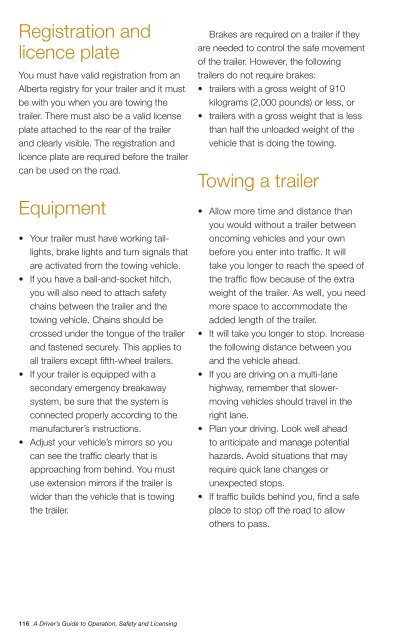DRIVER’S GUIDE
1POl7Ob
1POl7Ob
Create successful ePaper yourself
Turn your PDF publications into a flip-book with our unique Google optimized e-Paper software.
Registration and<br />
licence plate<br />
You must have valid registration from an<br />
Alberta registry for your trailer and it must<br />
be with you when you are towing the<br />
trailer. There must also be a valid license<br />
plate attached to the rear of the trailer<br />
and clearly visible. The registration and<br />
licence plate are required before the trailer<br />
can be used on the road.<br />
Equipment<br />
• Your trailer must have working taillights,<br />
brake lights and turn signals that<br />
are activated from the towing vehicle.<br />
• If you have a ball-and-socket hitch,<br />
you will also need to attach safety<br />
chains between the trailer and the<br />
towing vehicle. Chains should be<br />
crossed under the tongue of the trailer<br />
and fastened securely. This applies to<br />
all trailers except fifth-wheel trailers.<br />
• If your trailer is equipped with a<br />
secondary emergency breakaway<br />
system, be sure that the system is<br />
connected properly according to the<br />
manufacturer’s instructions.<br />
• Adjust your vehicle’s mirrors so you<br />
can see the traffic clearly that is<br />
approaching from behind. You must<br />
use extension mirrors if the trailer is<br />
wider than the vehicle that is towing<br />
the trailer.<br />
Brakes are required on a trailer if they<br />
are needed to control the safe movement<br />
of the trailer. However, the following<br />
trailers do not require brakes:<br />
• trailers with a gross weight of 910<br />
kilograms (2,000 pounds) or less, or<br />
• trailers with a gross weight that is less<br />
than half the unloaded weight of the<br />
vehicle that is doing the towing.<br />
Towing a trailer<br />
• Allow more time and distance than<br />
you would without a trailer between<br />
oncoming vehicles and your own<br />
before you enter into traffic. It will<br />
take you longer to reach the speed of<br />
the traffic flow because of the extra<br />
weight of the trailer. As well, you need<br />
more space to accommodate the<br />
added length of the trailer.<br />
• It will take you longer to stop. Increase<br />
the following distance between you<br />
and the vehicle ahead.<br />
• If you are driving on a multi-lane<br />
highway, remember that slowermoving<br />
vehicles should travel in the<br />
right lane.<br />
• Plan your driving. Look well ahead<br />
to anticipate and manage potential<br />
hazards. Avoid situations that may<br />
require quick lane changes or<br />
unexpected stops.<br />
• If traffic builds behind you, find a safe<br />
place to stop off the road to allow<br />
others to pass.<br />
116 A Driver’s Guide to Operation, Safety and Licensing


